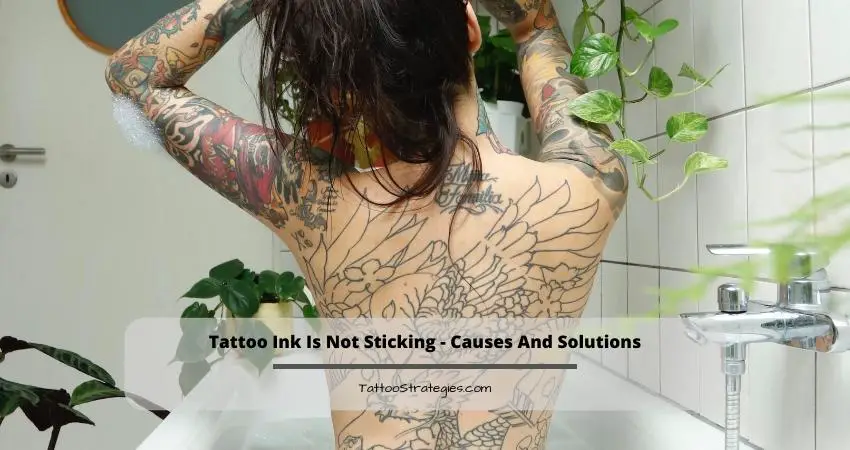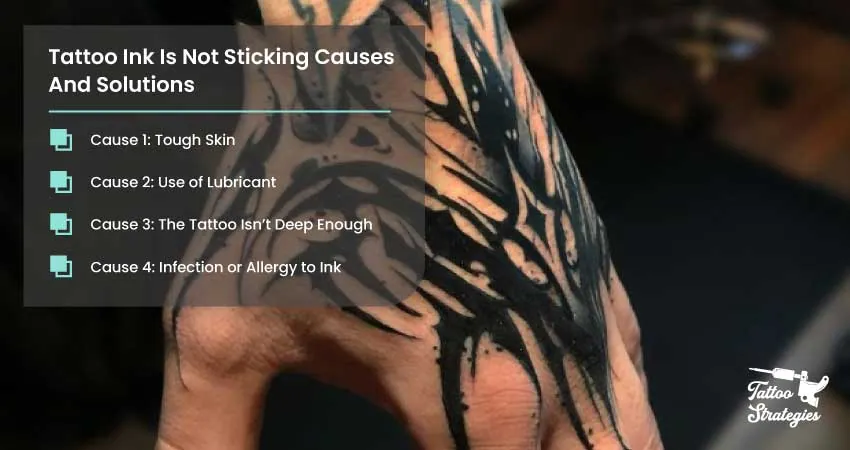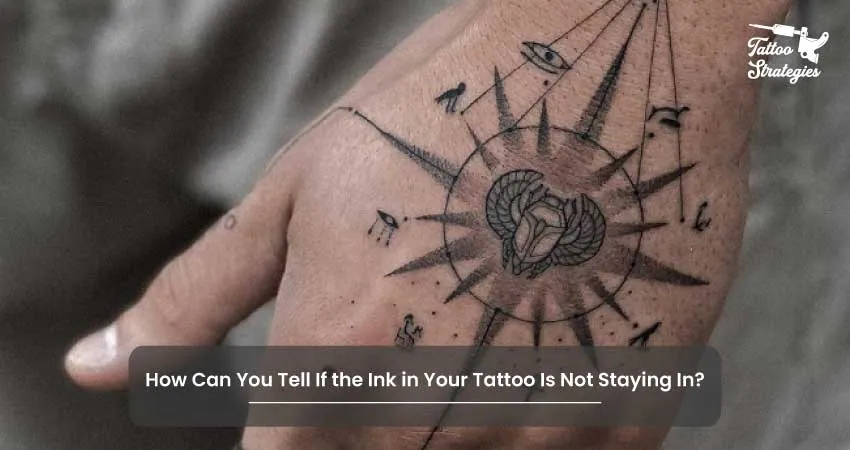Why Would Tattoo Ink Not Take?
One of the issues related to tattooing is, ink not staying in the skin. Unfortunately, this issue always goes under the radar. That’s why it is not surprising if you think, “why won’t my tattoo ink stay in my skin?”
Your skin’s rejection of tattoo ink has a number of causes. It could be due to your hard skin, the lubricant used while the tattooing process, the depth at which the tattoo was inserted into your skin, or due to infection caused by the ink.
Whatever the issue, there are ways to identify it and solve it. This article will enlighten you regarding all of these issues and more.

Why Would Tattoo Ink Not Take?
Tattoo ink that the skin rejects is a very rare occurrence. In general, it is better for both you and your skin to use a credible artist in a recognized shop.
Moreover, you should contact your tattoo artist and doctor without hesitation if you suspect any problems with your tattoo ink.
You need to figure out why your skin isn’t taking the tattoo ink well before proceeding forward. For several reasons, your tattoo ink might not be set in, and there are a variety of remedies available.
You must locate the issue and work with your artist to develop a plan for fixing it before you can make any repairs, especially if you want to avoid a repetition of the current situation.
Tattoo Ink Is Not Sticking – Causes And Solutions

If your tattoo ink is leaking right after you get your tattoo can be a terrifying thing to see. You might wonder, “why is my skin not taking tattoo ink?”. There are a few causes why this might happen.
Let’s see some of the causes as well as their solutions below:
Cause 1: Tough Skin
Many people, by luck, have extremely strong skin. There isn’t much that can be done without potentially damaging the skin. Therefore, even the most skilled tattoo artist might not know how to deal with this problem and manage the skin.
If not properly trained, the ink will not stick to the skin, which will make the tattooing process a lot worse than before.
Solution
Find a tattoo artist that has experience tattooing on tough skin and has developed a successful technique for doing so if you find yourself in a scenario like this.
Cause 2: Use of Lubricant
As odd as it might seem, there are times when the lubricant the tattoo artist used while working on you may be functioning as a barrier between the ink and your skin.
It’s possible that the lubricant entered your skin’s pores and even led to blockage if they’ve previously used a lubricant known to create this barrier, like petroleum jelly, for instance.
This would indicate that further attempts to inject ink into those regions would fail since it would have nowhere to go but back up to the surface.
This indicates that no matter how many rounds the needle passes in and out of the skin, the ink will constantly be forced back up since the lubricant will not let it flow through.
Solution
Fortunately, the solution to this problem is simple: restart the tattooing procedure on a different skin area, and change the lubricant used.
You shouldn’t have any issues this time, and the tattoo ink should stay in place without complications if a better lubricant is applied.
Cause 3: The Tattoo Isn’t Deep Enough
Your tattoo artist may not have tattooed deeply enough into the skin, a typical cause of tattoo ink that may not adhere to the skin.
Most of the ink from this tattoo will typically come out when it heals if your tattoo artist just tattoos through the top layer of skin. The second layer of skin, known as the dermis, is the correct layer that should be tattooed.
This is because your skin will treat the tattoo in this layer of skin like a severe sunburn or a small cut, pushing out everything it considers to be toxic or infected.
The unwanted component that shouldn’t be forcing its way out of your skin will then be cleared by doing so. The fluid will then develop a scab, typically containing much of it. As the wound heals, the scab will come off and take the component.
Your body will treat your tattoo ink the same way when it is present in this layer of skin. It will push the ink out, turn it into a scab, and then pull it out along with the ink.
Solution
Again, fixing this is not hard. Simply completing the tattoo correctly and making sure the right layer of your skin is being tattooed will prevent this issue.
Cause 4: Infection or Allergy to Ink
After having a tattoo, many people may face common issues, including allergies or an infection.
Allergies can be caused by various things, including the artist’s gloves, the lubricant, or the ink used. Consult your tattoo artist and a doctor if you notice any unusual spots or rashes close to the area that has been inked.
However, remember that when a new tattoo begins to heal, red, swollen skin will develop. To determine what you are experiencing, carefully research the signs of illnesses and allergic reactions.
Solution
If you experience an allergic reaction, ask the artist for the name and chemicals of the ink.
Your doctor will then ascertain the reason for your body’s reaction. Finding an ink brand that works for your body should make it easier to avoid future allergic reactions.
To prevent infection, a proper after-care routine should be followed, and hygiene requirements must be followed. Your tattoo artists will always provide you with tips on how to take care of your new ink and assist in fast healing.
How Can You Tell If the Ink in Your Tattoo Is Not Staying In?

It’s possible that the ink from your tattoo is still there, and you may not have been aware of it when it was healing.
For instance, when you wash your tattoo for the first time after getting it done, you could be startled when the ink drips off into the water.
The ink you are seeing is not the ink that has begun to erupt from your skin; instead, it is the leftover ink that was scraped off during the tattooing procedure.
You might be concerned if, after a few days, your tattoo appears to be much lighter and if tiny, dark scabs start to fall off, but this is only the tattoo’s healing process. Your tattoo will return to its previous form and appear as good as new after fully healing.
You should get in touch with your tattoo artist if your tattoo does not look perfect after healing and there are ink loss patches.
Frequently Asked Questions
What does it look like when your body rejects a tattoo?
Can your body eliminate the ink from a tattoo?
Fortunately, a tattoo outburst isn’t a major problem that could jeopardize your health.
When your skin rejects tattoos, what does that mean?
Conclusion
It is important to identify the root of a cause before analyzing it. As we have already discussed, there are plenty of reasons why skin might not accept tattoo ink. So, if you encounter this situation or already have encountered it, don’t panic. Rather follow the fixes or contact your tattoo artist to overcome the problem.
